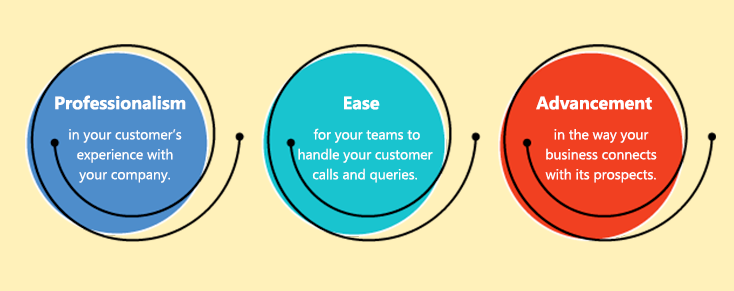Businesses often look for tools which would bring automation to their routine operations, increase the efficiency of their employees, and reduce the extra time otherwise spent in repetitive tasks.
According to a report from McKinsey, 29% of customer service agent duties have the potential to be automated with technology.
Reference: Boomtown
Well, at least, 6/10 businesses who want faster and combined growth do look in this direction.
There’s a reason why AI and chatbots have become so popular amongst businesses. They significantly reduce the manual effort of agents alongside ensuring the fastest possible redressal of customer inquiries.
Now, besides serving customers on chatbots, there are certain types of businesses, whose major revenue is dependent on calls. The on-call discussion happening between the prospect and agent is the key deciding factor of their conversion.
Needless to say, in this scenario, most of their customer-facing employees are dedicated to call-related activities only.
Good customer experience, smooth on-call discussion, faster resolution on calls, effective monitoring of customer calls, all these are no more an option but a necessity for these businesses.
Wondering why? Well, without the above-mentioned requisites, winning customers through calls will become more challenging than ever.
Now, fulfilling these requirements is what we’re going to talk about here and how a call automation system serves the purpose. As a matter of fact, from attending to transferring to monitoring, all this doesn’t demand more hiring but more automation.
So, here are a few ways in which the conventional methods of call-related activities should be replaced by a modern call automation system.
Manual Easy transferring of calls
There was a time when businesses used to have an office landline phone for their customer support. Employees in their “9 to 5” job used to be around that landline to take/make calls.
Then came a time when mobile numbers were published as business contact numbers. One number of sales, other for support, another for HR and so on. In this case, different numbers were published for a single business, and if the call is placed on the wrong number, the agent had to handover the mobile to another department.
What’s new? A centralized business number for all departments. One virtual number will have all the agent’s mobile numbers mapped behind it. The call will be connected with the department basis the caller’s selection in the IVR menu. In case, the call is connected with the incorrect department, it can be easily transferred to the concerned agent by simply calling on their extension number.
Delayed Faster on-call resolution
In the above-stated first scenario, when the customer dials the business contact number, there used to be a high probability of line being engaged or simply no response during non-working hours.
Let’s face it, we can’t expect our prospects to dial our contact number repetitively to hear our product pitch. They are always on the verge of going to the competitors to know about their product. This is why landlines were always an “unreliable” mode of customer communication.
Coming to mobile numbers. Here again, there are high chances that the call might not get connected due to another ongoing call, network issues, or unavailability of the agent. Hence, high chances of losing a potential business opportunity.
What’s new? As the customer dials the virtual number, the call is sent to multiple agents at the same time. Therefore, the chances of all 5-10 agents being unavailable at the same time are almost nil. Certainly, a call automation system like this will ensure a faster response time to your customer calls and queries, and minimal chance of losing a potential client.
One Multiple calls at a time
While calls were attended on a landline system or a mobile phone, a business could attend only one call at the same time. Obviously, during one ongoing call not only the other call was missed, but the phone number of those missed calls too couldn’t be fetched for a callback.
While a business invests heavily in marketing, they should be ready to receive a good number of calls from prospects, and this with the conventional phone systems couldn’t be ensured.
Obviously, if the team or supporting system wasn’t efficient, this resulted in a significant number of calls and customers being missed, hence gave more conversions to competitors.
What’s new? With a call automation system, businesses are now empowered to take multiple calls parallelly. Your 5 different customers can call you, at the same time, on your business number, and their calls will be connected to 5 distinctive agents. All this, without any additional effort of your team to work overtime or being limited to a particular phone system.
Obviously, who would want to miss the customer’s call and increase the chance of them dialling the competitor’s number instead? Not you, hopefully!
Inconstant Real-time monitoring of calls
While businesses have different agents and teams to interact with customers on calls, with a landline number or mobile number, monitoring their performance was next to impossible. Without proper reporting or hearing conversation, keeping a tab and improving agent’s performance of calls couldn’t be achieved.
Certainly, you can’t make your quality-check manager be around agents every time to hear their conversations.
As a result, the head management used to remain unaware of how their employees are interacting with the agents, how many calls the agents are missing, and so on.
Result? Poor customer experience with absolutely no data to work on.
What’s new? Constant and reliable monitoring is what’s needed here, call automation system is what’s needed here. In the era of mobility in team working, a panel that gives you exact reporting and recording of your agent’s performance on calls will help you ensure continual supervision of your business call activities and leverage changes as and when required.
Limitation Mobility in attending calls
When I previously mentioned about business calls being received from a landline phone only, this demanded agents to be around that one phone only. If no one was available around, calls and customers were left unattended, thus, impacting the company name and its service.
Situations like these were quite common during weekends and after office hours. Some businesses even made their employees stay late in the office or come during weekends as well to attend calls. But, did it turn out to be efficient? Obviously not!
What’s new? The concept of call automation system facilitates your employees to attend calls from their mobile phones directly, irrespective of their geographical location. What’s best is that the advanced cloud technology even records, tracks, and reports all calls made, received and missed, empowering the head management to monitor their team’s performance without any manual effort involved.
Embrace the future of customer support with a call automation system
The advancement in technology has paved the way for businesses to revolutionise their level of service to match the higher expectations of customers. Most of the new technologies in call handling is designed in a way to help customer-facing professionals do their jobs efficiently and easily.
“Below-the-level” customer support does not only impact the efficiency of your team but also poses a question on the quality of your services.
Let’s face it. The way your pre-sales experience will be, it will significantly impact your prospect’s decision of going ahead. The more advancement your in-house features are, the better the impression you will be able to create in front of your prospects.
Well, the progress in the customer service industry is just too fast and effective for this (impact your sales conversion and brand impression) to not happen.
In a time when most companies are able to provide exact features, at times, even at a far lesser cost, it’s your customer service & experience that will help you close the lead.
Businesses can’t (and shouldn’t) wait to take their customer experience to the next level, and this is why I’m introducing you to our call automation system.
The MyOperator Call Automation System
MyOperator is a cloud-based call center software solution built with the objective of transforming the way businesses communicate with their customers. Irrespective of the business size, we believe that each business should have a streamlined and professional way of allowing its customers to connect with them through calls.
Not only these calls are sales calls, but looking at the broader horizon, it also encompasses automated calls for recruitment, feedback, confirmation, marketing, important notification and more.
Our Call Automation System is designed with features suitable for all business needs and objectives:
- Virtual phone numbers for streamlined and simultaneous call handling.
- Tollfree numbers for a professional and upgraded way of customer communication.
- Office IVR solution for businesses seeking easy call management and reliable reporting.
- Live panel as a platform for real-time and effective monitoring of business call-related activities.
- Call masking solution for ensuring the privacy of the executive as well as the customer.
- Outbound calling solution to keep a track and record of your customer conversations.
- Cloud call center solution for businesses which seek advancement in call reporting.
- Multi-store solution for businesses with widespread branches yet needs common reporting.
In sum, the prime objective of our call automation system is to bring:

All this without any additional effort but with all the required advancements and ease.



